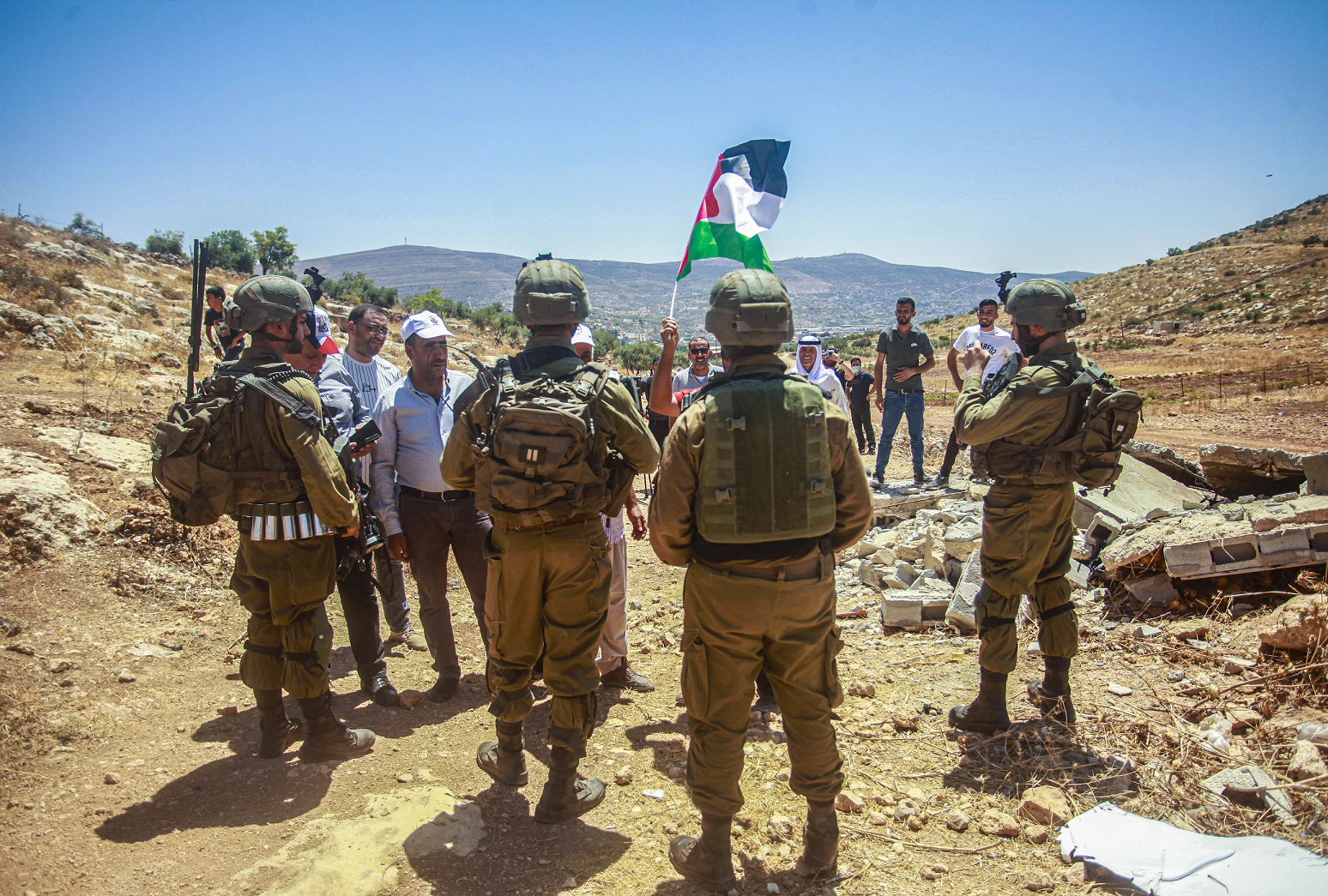Publications
Special Publication, August 23. 2023
Israel and the Palestinian Authority are struggling for control of Area C, which makes up about 60 percent of the West Bank. The PA contends that Area C, with agricultural land, access to Jordan, natural resources, space for infrastructures, and residential construction, should be a central and essential part of the future Palestinian state. However, the aim of the current Israeli government is to establish Israeli control over all Area C, significantly expand Israeli settlement there, and prepare the conditions for Israeli sovereignty over the area.
In strategic terms, in order to keep the State of Israel Jewish, democratic, secure, and thriving, the creation of a one-state reality must be avoided. It is therefore vital to implement moves toward political, geographic, and demographic separation from the Palestinians. The “Palestinian package” that was proposed in discussions on normalization between Israel and Saudi Arabia is an opportunity for Israel to change its approach to Area C, from unilateral takeover to a designated space for understanding with the Palestinian Authority and the Arab world. It is also an opportunity to recruit Saudi and Gulf states support for economic and infrastructure projects that will strengthen the status of the PA as a relevant partner for agreements and help shape the separation between Israel and the Palestinians.
The Current Situation
Area C, a product of the Oslo Accords, comprises 60 percent of the West Bank and is under Israeli civilian and security control. In 1995, under the Oslo II Accord, it was committed that the area be "gradually transferred to Palestinian jurisdiction" (with an option for land swaps under a final agreement), but such transfer did not happen. Jewish residents in the area number half a million, spread over more than 150 settlements, including illegal outposts, covering 4.5 percent of the territory. At the same time, Area C is home to over 200,000 Palestinians in over 530 towns and villages located partially or fully in Area C. The Palestinians have seized a quarter of the land – 5 percent for institutions and housing, and about 20 percent for agriculture and pasture. State land and unassigned land constitute 60 percent of the area.[1]
Israeli governments see Area C as essential for Jewish settlement and security, and as an asset in future negotiations. By contrast, the Palestinians see Area C as essential for a contiguous, sustainable, and viable Palestinian state.
The Palestinian Approach
Extent of the territory
In the eyes of the Palestinian Authority, Area C is intended to form a central and vital part of the future Palestinian state for the sake of territorial contiguity, particularly given that it includes agricultural land, natural resources, and space for the construction of infrastructures and rural and urban expansion.
The main objective of the PA is to prepare the conditions for taking over most of Area C. In this framework, it seeks to create contiguous settlement by Palestinians between districts; create a chokehold around Jewish settlements to prevent their expansion; and control main transport routes and direct access to the Kingdom of Jordan. It has therefore set up a government ministry to supervise activity in the area, map out Palestinian needs, and prepare plans.
In 2009, the PA began to formulate the Fayyad Plan, under then-PA Prime Minister Salam Fayyad, based on the conviction that a Palestinian state must be built from the bottom up. Subsequently the Campaign for Area C was formulated, designed to subject most of Area C to Palestinian sovereignty. The plan was funded by a foreign budget and also embodied in a European Union resolution that stated that the Palestinians can operate in Area C not only for humanitarian and economic reasons, but also to promote a political settlement and as a response to Israel’s expansion of settlements.[2]
The Palestinian intention to take control of Area C includes registering Palestinian ownership of the land. According to a Ministry of Intelligence report, in recent years the Palestinian Authority has invested much effort in the registration of land, exploiting a legal vacuum that was created when Israel froze the process of land regulation in 1968 for legal reasons and to save resources. At the same time, the Palestinians are engaged in legal efforts to prevent the demolition of illegal construction (mainly public buildings) and have obtained authorization for 113 unauthorized villages. Following the Israeli disengagement from northern Samaria (2005), there was considerable growth in the scope of Palestinian construction in that region, and the area of land taken over has jumped by 150 percent. The PA’s actions in the area have European backing, and the Palestinians are operating with European funding to register the Palestinian land.[3] In the background, it is clear that the Palestinian population is preparing to take control of Area C, as shown by the use of its agricultural and grazing land.
The Main PA Efforts with Respect to Area C:
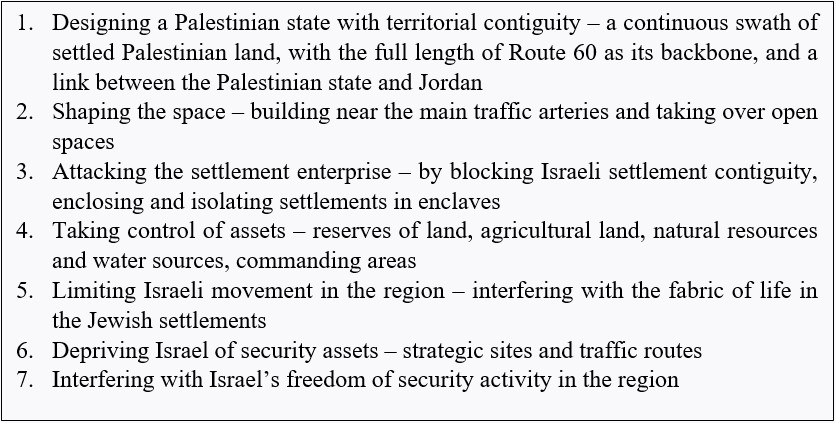
The Economic Dimension
A special study published by the World Bank[4] estimates that the economic potential of Area C could yield a significant boost to the GDP of the Palestinian Authority:[5]
- Agriculture: access to fertile land and irrigation water giving the Palestinians about 326,000 dunams for agriculture. The additional agricultural yield would be worth an estimated $740 million (7 percent of the Palestinian GDP). Agricultural development agreed by and in cooperation with Israel would facilitate improving the condition of the land and reducing contamination.
- Minerals from the northern Dead Sea: with international help, this could yield $918 million for the Palestinian economy.
- Quarrying and mining: the PA’s largest export industry. Granting quarrying and mining approvals in cooperation with the PA and Israel could double production and add $241 million. Currently these activities occur without approval and cause environmental damage.
- Construction: Israel only approves isolated building percentages, leading to overcrowding and rising housing costs. A change of policy and increased building approvals would lead to a gain of about $239 million.
- Tourism: there is no approval for investments and access to tourism sites in Area C, apart from the northern Dead Sea, which is an internal Palestinian tourism destination. Hotels and tourism could add $126 million.
- Telecommunications: cellular communications and internet are delayed by a lack of lines and fibers. A change in policy could yield an additional $48 million.
- Jordan Valley: this could be developed as a region of urban centers with agriculture to provide food. There is also potential in the fields of energy, infrastructures, and industry.
The overall contribution to the Palestinian economy from exploiting the potential of Area C is estimated at about 35 percent of GDP, which means an extra $3.4 billion for the Palestinian budget. Such development would also have indirect benefits: reduction in unemployment, advancement of Palestinian economic independence, reduction of the PA debt, rise in external investment, and improved transport and governance.
The Israeli Approach
In Israeli eyes, Area C is intended for Israeli settlement in the West Bank (all settlements and outposts are in Area C). The territory includes western and eastern security spaces, IDF bases, and other strategically essential sites and traffic arteries. However, Israeli interests, and particularly those relating to settlement and the future of the territories, are disputed and reflect different approaches within Israeli society.
The current Israeli government, composed entirely of parties and factions on the right of the political map, is promoting a reversal in the concept of state control of the West Bank, with the emphasis on Area C. The government’s objective is to establish Israeli control over all of Area C, prepare the conditions for its annexation to the State of Israel, and thwart any possibility of a future settlement based on the two-state approach. A further aspect of this change is the adoption of the strategy of the Minister in the Defense Ministry, Bezalel Smotrich, to defeat the national aspirations of the Palestinians. The first step toward this objective is to push them out of Area C.
For 55 years, Israel’s control of the West Bank rested on 3 principles: (1) keeping the area as calm as possible by means of an ongoing confrontation against terror infrastructures and IDF freedom of action throughout the region; (2) buying time until conditions are ripe for a political settlement, while taking the needs of the Palestinian population into account; (3) promising the international community that the territory of the West Bank is disputed, and that until agreement is reached over its future, Israel holds it under military belligerent occupation (according to international law), i.e., temporarily. The conceptual change advanced by the current government prescribes fighting for every part of Area C – expanding settlements; setting up new unauthorized outposts and subsequently approving them; setting up agricultural farms; expanding grazing land, agriculture, and employment for Israelis in the West Bank; undertaking massive demolition of illegal Palestinian construction, while rejecting 98 percent of Palestinian building applications; pushing Palestinian agricultural activity out of Area C; strengthening the components of Israeli control of the West Bank (including transfer of powers from the Defense Ministry and from the military commander to Minister Smotrich and civilian elements subordinate to him). All this is intended to create the conditions for imposing sovereignty on Area C.
The Security Dimension
The Israeli approach sees Area C as central to the security of the Israeli space – security areas to intercept terrorists as they prepare and embark on terror attacks, manage an ongoing campaign to dismantle terror infrastructures, and prevent the entry of hostile military capabilities and weapons into the area. At the same time, the security establishment, principally the IDF and the Israel Security Agency, is required to protect Israeli settlements in the West Bank and the main traffic arteries to and from them. Area C includes three regions defined as of vital interest: the eastern security space – the Jordan Valley, to act as a barrier in the event that Jordan changes its approach to Israel, or in the scenario when it is taken over by hostile forces who set up a new eastern front against Israel; the Jerusalem perimeter, which is the basis for protection of Israel’s capital and access to it; and the western security space – the area controlling the topography of Israel’s depth and its strategic sites (such as Ben Gurion Airport). Most of the area is limited by a security barrier and in effect defines the strategic depth for limiting security dangers and terror attacks in the heart of Israel. However, there is a public and professional debate in Israel over the contribution of Israeli settlements in the heart of Palestinian territory to the overall security of the State of Israel, or whether it is in fact a security burden that demands significant allocation of forces for its defense, forces that are needed for other security missions, and also creates ongoing and increasing friction with the Palestinian population, strengthening their motivation to commit acts of terror and thus harm security.
The Settlement Dimension
The policy on settlements and outposts aims for contiguity of Israeli settlements in order to create a barrier between Palestinian areas as a means of thwarting the establishment of a Palestinian state, with future separate Palestinian enclaves (cantons) that will be surrounded by sovereign Israeli territory.[6]
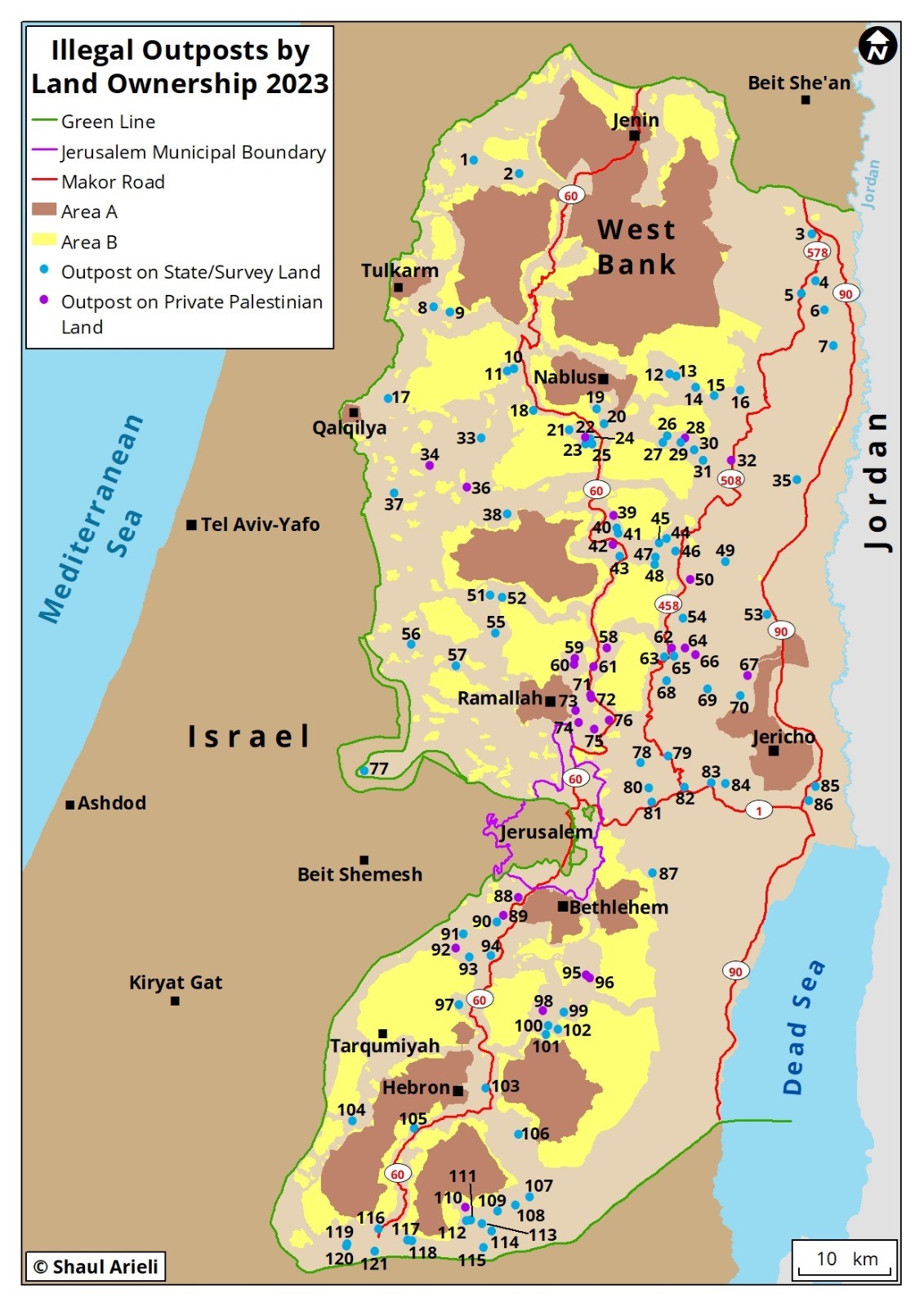
According to the approach that drives the more extreme ideological settlers and their supporters in the public and in the government (mainly those belonging to the radical religious Zionism movement), the religious commandment to settle the land of Israel is equal in weight to all the other commandments together. They claim that settlement requires the IDF to protect the villages and their traffic arteries, since in that way they prevent the Palestinians from taking control of open areas and tighten Israeli control over them. In order to push Palestinian presence and activity from Area C, farms are established and large areas for pasture are seized.[7] At the same time, there are those who object to the settlement policy, since it frustrates any future political settlement, increases friction with the Palestinian population and prevents their development, fuels international criticism of Israel, and stretches IDF forces to the limit by requiring investment of forces and extensive military efforts to protect the settlements and their transport routes.
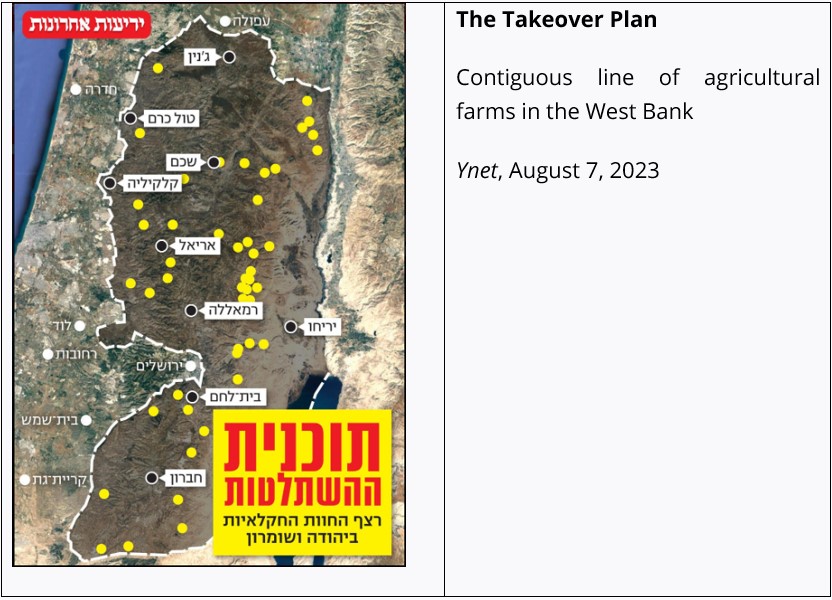
The Question of Sovereignty / Annexing Area C
The sovereignty issue is also at the heart of a deep dispute within Israeli society. A number of ideas have arisen around the subject: (1) applying sovereignty in the Jordan Valley, which would define Israel’s eastern border and prevent the Palestinian “right of return” through the eastern border (2) applying sovereignty / annexing only settlement areas (built-up or jurisdiction areas) (3) annexation of settlement blocs according to the route of the security barrier (4) annexation of all Area C (5) annexation of half of Area C, as reflected in the “deal of the century” proposed by United States President Donald Trump (2020).
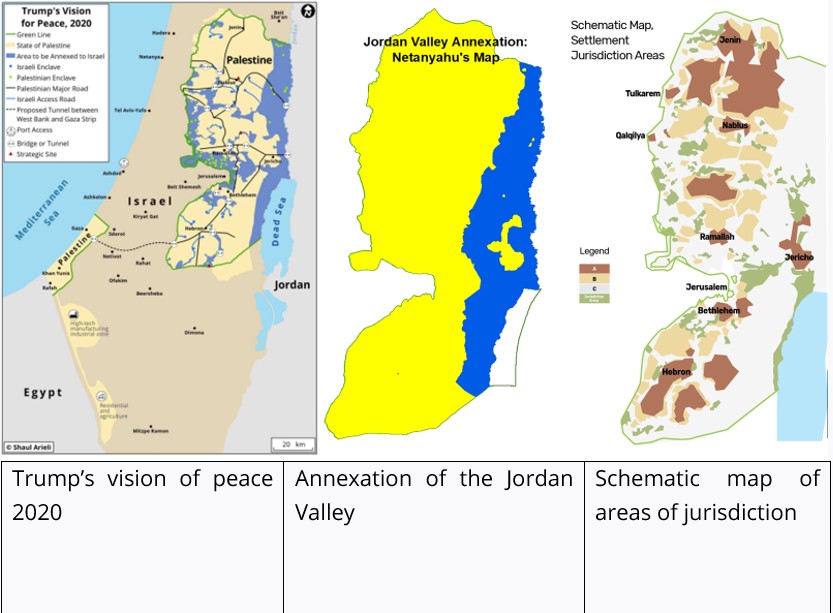
The central idea advanced by the current government is prepare the conditions for annexation (some refer to the steps taken as “creeping annexation”) by means of a number of moves, specifically: transferring the powers of the civilian administration to a minister in the Ministry of Defense (Bezalel Smotrich) and expanding the settlement project by means of “regulating the young settlements,” in other words, legal recognition of illegal outposts. Minister Smotrich, who was granted civilian powers in the West Bank, published an article entitled “The Decision Plan,” in which he stressed that the task is to “sear into the mind of the Arabs and the entire world that there is no chance of establishing an Arab state in the Land of Israel.” He also believes that the Palestinian should be given two options: migrate to an Arab country, or submit to Israeli rule as residents of autonomous cantons.[8]
At the Knesset Foreign Affairs and Defense Committee, Minister Smotrich revealed that the government is working on a change of policy in which it will also work to enforce building regulations in Areas A and B, and that work is underway to improve enforcement in the framework of the Settlement Administration in the Ministry of Defense that is subordinate to him. A special Border Police tactical unit will be set up for enforcement in the West Bank. Minister Smotrich also revealed plans for the JNF to plant forests in state land in the area, for hundreds of thousands of dunams to be allocated for agriculture, and for legal authorization of over 50 agricultural farms.
Implementation of government policy for Area C means sliding into a situation of one state – de facto annexation of land to thwart any chance of a political settlement with the Palestinians and realize the vision of separation from them. Creeping annexation is already weakening the Palestinian Authority and harming its ability to perform its function of managing Palestinian life in the West Bank. Annexation will lead to further weakening of the PA and even its final collapse, forcing Israel to assume full responsibility for the daily lives of almost three million Palestinians living in the West Bank. In addition, annexation and unilateral settlement that treat the current situation as permanent rather than temporary put Israel in a difficult position in the face of international criticism and accusations of apartheid. Assimilation of Palestinians into Israel in an atmosphere of ongoing hostility rather than as part of a joint political settlement will increase friction, aggravate identity challenges, fuel religious and nationalist battles, and lead to an escalation in crime, terror, and violent protest, as well as greater challenges to governance. In the long term, the Israeli-Palestinian demographic balance will undermine the basis of Israel’s mission – a Jewish and democratic state – and turn it into one state marked by Jewish supremacy or a state for all its citizens.
Conclusion and Recommendations
In strategic terms, maintaining Israel as a Jewish, democratic, secure, and thriving state demands a halt to trends of mixing populations in the West Bank and sliding into a reality of one state. This requires creating the conditions for political, geographic, and demographic separation from the Palestinians, while shaping a responsible, stable, and effectively functioning Palestinian Authority that cooperates with Israel.
In order to promote the objectives of separation from the Palestinians and stop the slide into a one-state reality, Israel must first and foremost change its approach to Area C from seizing control unilaterally to designating it as a space for understanding with the Palestinian Authority. Up to 35 percent of Area C should be allocated for developing infrastructures and economic projects to encourage the Palestinian economy, create transport contiguity, and transfer land occupied by Palestinians who have spread beyond the borders of Areas A/B to Area C to Palestinian control (over 200,000 Palestinians now live in Area C). As part of the allocation of land for development, a special committee will be set up, including international elements, to initiate projects in Area C. In the first stage Palestinians will not be granted zoning and planning authorities in this area, until work has started on projects, and the Palestinians provide proof of execution and take responsibility. The Jewish settlements should not be evacuated, but current settlement policy should be suspended: all illegal outposts and unauthorized farms should be removed, with priority given to construction and development in settlement blocs west of the security barrier route. The expansion of isolated settlements in the heart of Palestinian territory should be halted, except for the needs of natural increase, and Minister Smotrich’s policy of bringing in another half million settlers should be stopped.
The need for a “Palestinian package” arose in the framework of talks toward normalization between Israel and Saudi Arabia, i.e., some moves by Israel on the Palestinian issue that can be presented by Saudi Crown Prince Mohammed bin Salman and US President Joe Biden as an achievement that will contribute to realization of the two-state concept. In this context, at the Arab League summit in Riyadh in May 2023, Prince bin Salman said that “the Palestinian issue is at the top of the Kingdom’s agenda,” and mentioned the Arab Peace Initiative. In his York Times column,[9] Thomas Friedman referred to specific Saudi requests as part of the tripartite agreement with the United States: a formal promise not annex the territories; a halt to construction of new settlements or expansion of existing settlements beyond existing blocs; a promise not to regulate more illegal outposts, and the transfer of part of Area C under full Israeli control to Areas A and B that are under Palestinian control. Israel has an interest in promoting a normalization agreement with Saudi Arabia due to the country’s strategic, economic, religious, and political importance – and its weight in an anti-Iran axis. The recent evident willingness of the Palestinian Authority to participate in the political game and not be left behind, encourages thinking in the direction of promoting economic and infrastructure projects in Area C. The following are a number of possible projects:
- Improving joint control of border crossings: better standards of service and infrastructure, with particular emphasis on the Allenby crossing into Jordan, and involving the Palestinian Authority in its operation.
- Construction of a joint airport in Hyrkania Valley for Palestinian and Israeli travelers and pilgrims. This will encourage more investment in the region. Also needed are land ports in Tarqumiyeh and near Shaar Efrayim, to check export and import goods for the Palestinian Authority.
- Electricity – connection to gas supply from Israel, plus construction of Palestinian power stations to cover the gap in electricity supply. Also, facilities for generating green energy – solar and wind (solar fields in the Judean Desert) with connection to the distribution network, in order to decrease Palestinian energy dependence on Israel.
- Water – renewal of the activity of the Joint Water Committee. Allocation of coastal land to set up a desalination station for the Palestinians with Saudi or international finance; construction of Palestinian waste-water purification facilities in the West Bank with suitable pipes, to recycle water for agriculture.
- Development of the Jordan Valley as a shared economic zone for Israel, the Palestinian Authority, and Jordan, and its connection to other Arab countries. Involving the Gulf states will facilitate the progress of large, cross-border projects (such as the infrastructure backbone from the Arabian Gulf to the Mediterranean).
- Connecting the PA to multilateral regional architecture (water in exchange for energy between Israel, Jordan, and the UAE; joint projects in the fields of technology, tourism, employment, and transport).
- Establishing farms to promote Palestinian marketing of fruits and vegetables, while preventing pollution of the aquifer.
- Environment – stopping processes that pollute air, water, and land (discharging sewage into wadis and rivers, polluting the land and the aquifer with untreated wastewater, burning pollutants, prohibited dispersal of electronic waste).
- Climate crisis – promoting joint projects to serve multilateral interests, with the help of Israeli technology.
Execution of some or all of these projects will strengthen the status of the Palestinian Authority on the domestic and regional fronts and position it as a relevant actor in achieving settlements, and will also help Israel’s regional integration. Moreover, moves in this direction will help quell the growing conflict between Israel and the Palestinians, and in particular, prepare the conditions for two separate and distinct entities.
_______________________
[1] K. Eliraz, “Alternative Policy in Judea and Samaria,” Hashiloach, 31, September 2022, https://hashiloach.org.il/alternative-policy-in-judea-and-samaria/ [in Hebrew].
[2] Ministry of Intelligence, The Palestinian Campaign for Area C – Shaping the Security Situation on the Ground, Description and Significance, from: https://fs.knesset.gov.il/24/Committees/24_cs_bg_616988.pdf [in Hebrew].
[3] Palestinian Land Registry Research, Ad Kan, January 2023, https://www.adkan.org.il/tabo-re [in Hebrew].
[4] O. Niksic, N. Nasser-Eddin, and M. Cali, Area C and the Future of the Palestinian Economy. World Bank Study, Washington D.C., 2014.
[5] E. Tsanani. Area C: From a Region of Dispute to a Space of Creeping Peace. Petah Tikva: Mitvim Institute, January 2023, https://mitvim.org.il/publication [in Hebrew].
[6] M. Kedar, “The Ultimate Solution to the Palestinian Problem,” Ynet, November 14, 2008, https://www.ynet.co.il/articles/0,7340,L-3605141,00.html [in Hebrew].
[7] E. Ben Kimon, “Construction, Tree Planting, and Establishment of Farms: The Struggle for Control of Area C,” Ynet, December 13, 2021, https://www.ynet.co.il/news/article/hyokyunqf [in Hebrew].
[8] B. Smotrich. Decision Plan: The Key to Peace is on the Right,” Hashiloach, 6, 81-102, September 2017,
[9] T. Friedman, Biden Is Weighing a Big Middle East Deal, New York Times, July 27, 2023, https://www.nytimes.com/2023/07/27/opinion/israel-saudi-arabia-biden.html



